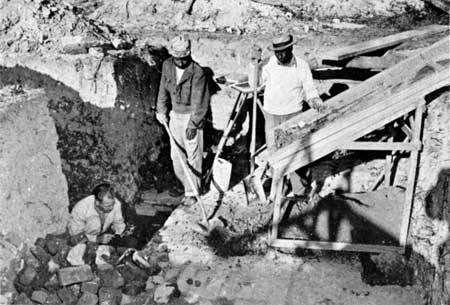|
JAMESTOWN National Historic Site |
 |

Early ceramic types found in the excavations.
Jamestown National Historic Site
The first organized effort toward saving the Jamestown area came in 1893 when the Association for the Preservation of Virginia Antiquities acquired 22.5 acres of the old townsite. This land, donated for preservation by Mr. and Mrs. Edward E. Barney, embraced the Old Church Tower, the graveyard, and the west end of the townsite.
The Association which was chartered in 1889 is better known, perhaps, as the APVA. It is a non-profit organization interested in the acquisition, preservation, and restoration of "ancient historic grounds, buildings, monuments, and tombs in the Commonwealth of Virginia" and in the collection and care of relics associated with them or with the history of the State. Its Jamestown property is one of a number of holdings which it administers. Another is the 17th-century Warren House on the Rolfe property in Surry County just across the James River from Jamestown.
Until 1934 the Association was the sole active agency working at Jamestown to conserve and interpret the site for the American people. As the custodian of a significant part of the site of old "James Towne," it continues working to promote measures insuring the protection of the site and making it available for your use and inspiration. Landscaping, limited reconstruction, some restoration, and the stabilization of the remains of the Old Church Tower, the tombs, and foundations have all been a part of its program; together with the acquisition and display of Jamestown relics. In its work, it has solicited and received aid from various organizations, particularly patriotic societies, in the placement of memorials, and related activities. The Memorial Church was constructed by the National Society of the Colonial Dames of America. The Association was especially active in preparation for the Jamestown Exposition in 1907.
The Association was successful in its efforts to encourage the United Stares Government to construct the seawall which was built by Col. Samuel H. Yonge in 1900-1901 to halt bank erosion by the James River along the Association grounds. Colonel Yonge became a serious student of Jamestown history and wrote The Site of Old "James Towne," 1607—1698, a work still available through purchase from the Association. In 1907, the Association made available the grounds on which the Tercentenary Monument was erected, and again in 1956 it provided land on which to place the Jamestown Visitor Center.
In 1940 the Association entered into agreement with the United States of America, through the Secretary of the Interior, to provide for a unified program of development and administration for the island. It was at this time that the APVA grounds were designated as Jamestown National Historic Sire. The joint cooperative agreement continues in force and the Association and the National Park Service are working together to preserve, maintain, and interpret this historic area.
In 1956 it became possible to present the townsite as a single unit when the ferry to the island and the State highway crossing the island were moved upriver above Jamestown. The APVA and the Service then combined their separate museum exhibits to form the displays now seen in the Visitor Center, and consolidated other operations at the center where both are hosts to Jamestown visitors.

Excavation in progress at Jamestown in
1955.
In 1930, by Presidential proclamation, all of Jamestown Island's 1,559.5 acres (equally divided between marsh and dry land) were included within the boundaries of Colonial National Monument. The monument designation was changed to that of a national historical park by act of Congress in 1936. Actual Federal ownership of the island (other than the 22-acre Association tract) was obtained in 1934, and some years later, a bit of the mainland opposite the western tip of Jamestown was added because of its close ties to the site.
Colonial National Historical Park is made up of several areas of which Jamestown is one. It includes, as well, the Cape Henry Memorial, at the mouth of the Chesapeake Bay, where the first settlers who established Jamestown first stopped in Virginia; the Yorktown Battlefield; and the Colonial Parkway.

|
|
Last Modified: Mon, Dec 2 2002 10:00:00 am PDT |


